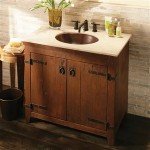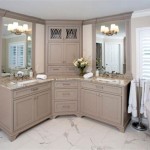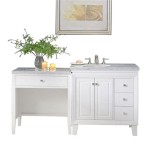Bathroom Vanity Cabinet Measurements: A Comprehensive Guide
Bathroom vanity cabinets are essential components of bathroom design and functionality. Selecting the appropriate vanity requires careful consideration of various factors, including the size of the bathroom, the desired storage capacity, and ergonomic comfort. Understanding standard bathroom vanity cabinet measurements is crucial for making informed decisions that optimize both aesthetics and usability.
The dimensions of a bathroom vanity directly influence the flow of traffic within the bathroom and the accessibility of plumbing fixtures. A poorly sized vanity can impede movement, create an unbalanced visual aesthetic, and even complicate plumbing connections. Therefore, this article provides a detailed overview of standard bathroom vanity cabinet measurements, offering guidance for selecting the right dimensions for various bathroom configurations.
Standard Vanity Height
Vanity height is a critical factor in determining user comfort. The standard bathroom vanity height has evolved over time in response to changing ergonomic considerations. Traditionally, vanities were typically installed at a height of 30 to 32 inches. While this height remains common in older homes, modern standards generally favor taller vanities.
The contemporary standard for vanity height is approximately 34 to 36 inches. This increased height is designed to minimize back strain and improve posture during daily tasks such as washing hands and brushing teeth. This height is often referred to as "comfort height." The shift towards taller vanities reflects a growing awareness of the importance of ergonomic design in promoting long-term well-being.
It is important to consider the height of the primary users of the bathroom when selecting a vanity. Taller individuals may find a 36-inch vanity more comfortable, while shorter individuals may prefer a 34-inch vanity or even a custom height. Custom-height vanities offer the greatest degree of flexibility, allowing for precise tailoring to individual needs and preferences.
The height of the sink basin can also impact the overall perceived height of the vanity. A vessel sink, for example, will add several inches to the total height, potentially making a 36-inch vanity feel even taller. Carefully consider the sink type and its impact on usability when determining the optimal vanity height.
Furthermore, consider the placement of the mirror and lighting fixtures in relation to the vanity height. The mirror should be positioned at a comfortable viewing angle, and the lighting should provide adequate illumination for performing tasks at the sink. These elements should work in harmony to create a functional and aesthetically pleasing space.
Standard Vanity Depth
The depth of a bathroom vanity cabinet refers to the distance from the front of the cabinet to the wall. Standard vanity depths typically range from 18 to 24 inches. The choice of depth depends on the available space in the bathroom and the desired amount of counter space and storage.
A vanity depth of 21 inches is often considered a versatile option, providing ample counter space without overwhelming smaller bathrooms. A depth of 24 inches offers even more counter space and storage capacity, making it suitable for larger bathrooms where space is not a limiting factor. Vanities with a depth of 18 inches are often used in powder rooms or small bathrooms where maximizing space is a top priority.
The depth of the vanity also influences the type of sink that can be accommodated. Some vessel sinks may require a shallower vanity to prevent them from protruding too far into the room. Undermount sinks, on the other hand, can typically be used with vanities of varying depths.
It's essential to consider the placement of plumbing lines when choosing a vanity depth. A deeper vanity may require adjustments to the plumbing to ensure proper connections. Consult with a plumber to assess the plumbing layout and determine the optimal vanity depth for the specific bathroom configuration.
The depth of the vanity's storage compartments is also a consideration. Deeper vanities typically offer more storage space, allowing for the accommodation of larger items. Consider the types of items that will be stored in the vanity and choose a depth that provides adequate space for organization.
Standard Vanity Width
The width of a bathroom vanity cabinet significantly affects the overall aesthetics and functionality of the bathroom. Standard vanity widths vary widely, ranging from compact units suitable for small powder rooms to expansive double vanities designed for master bathrooms.
Single vanities typically range in width from 24 to 48 inches. A 24-inch vanity is a common choice for small bathrooms or powder rooms where space is limited. A 30-inch or 36-inch vanity provides more counter space and storage while still being suitable for moderately sized bathrooms.
Vanities that are 48 inches wide offer even more counter space and storage, making them a good option for larger bathrooms. These wider vanities can accommodate larger sinks or provide ample space for toiletries and personal care items.
Double vanities, designed for two users to share the space, typically range in width from 60 to 72 inches or even wider. These vanities offer two separate sink basins and ample counter space for each user. Double vanities are a popular choice for master bathrooms, providing convenience and functionality for couples.
When selecting a vanity width, it is crucial to consider the overall layout of the bathroom and the placement of other fixtures. Ensure that there is sufficient space around the vanity for comfortable movement and access to other areas of the bathroom, such as the toilet and shower.
Also, consider the width of the doorway leading into the bathroom. A vanity that is too wide may create a bottleneck at the entrance, impeding traffic flow. Carefully measure the doorway and the available space within the bathroom to determine the optimal vanity width.
The style of the vanity can also influence the perceived width. A vanity with a minimalist design and clean lines may appear less bulky than a vanity with ornate details and a more traditional style. Consider the overall aesthetic of the bathroom and choose a vanity style that complements the existing décor.
Floating vanities, which are mounted to the wall without legs, can create the illusion of more space and make the bathroom feel larger. These vanities are a popular choice for modern bathrooms, offering a sleek and contemporary look.
Ultimately, the selection of bathroom vanity cabinet measurements is a critical aspect of bathroom design. Understanding standard heights, depths, and widths enables informed decisions that optimize both the functionality and aesthetics of the space. Careful consideration of user needs, bathroom layout, and plumbing requirements is essential for achieving a bathroom that is both comfortable and visually appealing, allowing for daily routines to be performed with ease and efficiency.

What Is The Standard Height Of A Bathroom Vanity Sizes Cabinets Vessel Sink

Plan Your Bathroom By The Most Suitable Dimensions Guide Engineering Discoveries Vanity Sizes Vessel Sink

Bathroom Vanities Buy Vanity Furniture Cabinets Rgm Distribution

What S The Standard Depth Of A Bathroom Vanity

Pin By Tania Rejalaga On Bathroom Ideas Vanity Sizes Dimensions Modern

Ws Vs30 Shaker White 30 Vanity Sink Base Double Door Drawer Front Cabinetselect Com

Floating Bathroom Vanity Furniture

Bathroom Vanities Buy Vanity Furniture Cabinets Rgm Distribution

What Is The Standard Height Of A Bathroom Vanity

All S Bathroom Dimensions Vanity Buy
Related Posts







